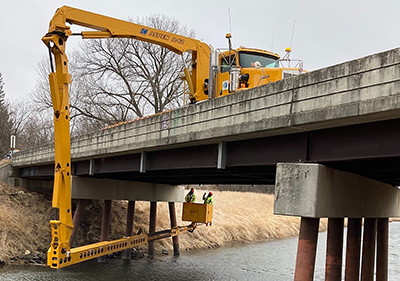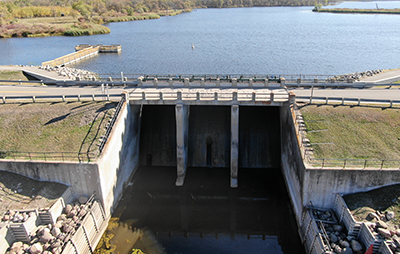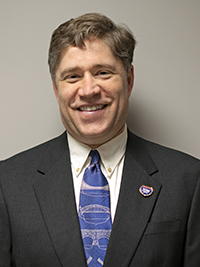|
By Joseph Palmersheim

Aaron Forthun and Anthony Bale, both bridge inspectors in District 6, take a peek at the underside of the Turtle Creek Bridge in in Austin. Photo by Mike Dougherty |
When you’re traveling over a bridge in the coming months, don’t be surprised if you see a snooper truck — or a drone.
MnDOT (along with county, city and consultant crews) inspects bridges between March and November, so the 2022 season has now begun. There are around 2,000 bridges across the state, including bridges on the state system as well as those owned by counties and cities.
Crews sometimes use snooper trucks, which have multi-joined arms with work baskets on the end. The equipment allows the inspection team to get under the bridge while the truck is on the bridge deck. Lane closures are usually scheduled when these types of inspections occur.
Some inspections use one of the 33 drones MnDOT added to its fleet in the last year. Most of these are DJI Mavic 2 Pro, a consumer-grade drone with 12-megapixel cameras. These are "more than adequate for a routine inspection," said Jennifer Wells, state bridge inspection engineer. Another type, the DJI Matrice 300, has more sensors and cameras on it, making it ideal for use on large structures that need detailed resolution for 3-D imaging. Finally, an Elios drone has a protective cage around the cameras and propellers, which allows it to go inside confined spaces like culverts or hollow bridge areas. The drones’ software programs record details of every flight, and a server stores this data.

Bridge Inspector Randy Aamodt took this picture of the Lake Bronson Dam using new advanced inspection equipment - a drone. Aamodt works as the North Region inspection specialist for State Aid, focusing on bridge inspections and assisting local agencies in Districts 1, 2, 3 and 4. Photo by Randy Aamodt |
"Drones can give us better access and better data," Wells said, "especially in metropolitan areas or other areas where we can't get a snooper under a bridge. The drones are able to give us access without having to do lane closures and work zones. It gives us more of a birds-eye view of areas we couldn't see before. They have such better cameras on them, too. You can get better quality data from that."
Future trends in the drone industry include semi-autonomous vehicles, which can take off from a portable base and do pre-programmed tasks. Other improvements include refinements to sensors that measure things like cracks in structures, and drones that can go underwater to explore culverts or other areas.
But for all the advancement, the human factor is still critical. "Bridge inspection can be subjective," Wells said. "One inspector may see something different than another. That is why it is important to have ongoing training and the best tools for access to get quality data. Our view is that [drones are] an enhanced tool that allows us to make better-informed decisions. It's not one that would replace inspectors or any of the tools we currently use."
Critical attention
Some bridges need more attention from inspectors than others.
Seventy Minnesota bridges are “fracture critical bridges.” These steel bridges are older designs. They have at least one member whose failure could cause a partial or complete collapse.
“Fracture critical” may be an alarming-sounding term, said Scott Theisen, engineering specialist senior with the CO Bridge Office, but it’s really just an engineering definition.
“It shouldn't imply that they are unsafe,” Theisen said. “It’s just the way they were designed. Not all of them are older. We've got the Hwy 60 bridge in Wabasha, which is a truss bridge built in 1987. Some of them are newer.”
Federal regulations require close inspection of fracture critical portions of these bridges every two years. And “close” means exactly that. Inspectors need to get close enough to physically touch every critical part of the bridge.
The amount of time to do this varies. A truss bridge with one fracture critical peer cap can take a few hours. On the other hand, the Blatnik Bridge in Duluth can take five crews up to three weeks to inspect. And with something that big, a snooper truck might not be enough. MnDOT inspectors (with training from the Society of Professional Rope Access Technicians) might need to rappel, with rope, down the side of the bridge. This gets to get close enough to see what they need to see, and then climb back up.
“Not being afraid of heights is a primary requisite for the job,” Theisen said. “With Blatnik, the bottom of the deck is 140 feet off the ground. The top of the truss is another 80 feet up, so you could be up to 220 feet in the air or more.”
Rating Minnesota bridges
Bridge inspections use a two-rating system to document condition. The first is a National Bridge Inventory component rating on a scale from 0 to 9. The higher the number, the better the condition. This rates the primary parts of the bridge (deck, superstructure, substructure, channel and culvert). The second rating is for each specific element of the bridge, assessed on a scale from 1 (Good) to 4 (Severe), based on guidance in the MnDOT Bridge Inspection Field Manual.
The FHWA requires all states to use both rating systems for National Highway System bridges. MnDOT uses both rating systems for all bridges, even those not part of the NHS.
All Minnesota bridges are on a one-year, two-year or four-year (culverts only) inspection schedule. Inspection frequency is based in part on previously noted conditions, load restrictions and age. The better the condition, the lower the risk and thus the longer the interval between inspections.
All reports go into SIMS, a statewide bridge inventory and condition database. Each bridge owner has a designated program administrator. They review and approve the inspection reports. The administrator develops an action plan based on any noted issues. Options can range from preventive maintenance to replacement.
|
 |
TABLE of CONTENTS
 |
Staffing updates |

Ed Lutgen is the state bridge engineer. Photo by Rich Kemp |
Ed Lutgen starts as new state bridge engineer
Ed Lutgen started as MnDOT’s new state bridge engineer on March 30. He succeeds Kevin Western, who retired from the position. Lutgen has 27 years of experience with the many aspects of bridge design and also served on mobility assignments as a district bridge engineer and in the Office of Materials and Road Research.
“My interest in bridge engineering started in my early grade school days, playing with Legos and Lincoln Logs,” Lutgen said. “I enjoy leading a team to solutions for complex bridge issues.”
Lutgen’s major MnDOT projects include the Granite City Crossing bridge in St. Cloud, several Blatnik Bridge preservation projects and the Interstate 35 corridor bridge preservation project in Duluth. He also served as the project manager on the consultant contract for the forensic investigation of the I-35W bridge collapse, work that included identifying the gusset plate cause and onsite investigatory reporting, coordinating with FHWA and NTSB, and engaging with people affected by the event.
“Ed brings a wealth of bridge knowledge and expertise to the position,” said Michael Beer, acting assistant commissioner for Engineering Services. “He has established himself as an expert both within the Bridge Office and supporting the districts and consultants. I’m excited to work with Ed. I'm also looking forward to his strong leadership and advancement of the Bridge Office. Finally, I also want to thank Nicki Bartelt for her leadership as the acting state bridge engineer after the retirement of Kevin Western.”
Before joining MnDOT in 2000, Lutgen spent five years as a bridge project consultant. He earned a Bachelor of Civil Engineering from the University of Minnesota.
Lutgen serves on the American Association of State Highway and Transportation Officials T9 Committee on Bridge Preservation and the T18 committee for Bridge Management, Evaluation and Rehabilitation; he is also is a member of the Federal Highway Administration Bridge Preservation Expert Task Group.
Doug Mack takes over as Newsline editor

Doug Mack is the new editor of Newsline. Submitted photo |
Doug Mack, an experienced journalist, editor and researcher in the nonprofit and for-profit sectors, makes his debut with this issue as the editor of MnDOT Newsline. He succeeds Joseph Palmersheim, who accepted a promotion to public affairs program administrator in the Office of Communications and Public Engagement.
Mack is a published freelance writer for national and regional publications, including The New York Times, Slate, Time and National Geographic Traveler, and is the author of two books—The Not-Quite States of America and Europe on Five Wrong Turns a Day. Most recently he served as marketing manager and researcher for MacDonald & Mack Architects. He has a Bachelor of Arts in American Studies from Carleton College.
Besides editing Newsline, Mack will be the point person for NoteMailer messages, MnDOT’s business-related emails to employees, and will serve as primary editor of many of the agency’s reports.
“Doug’s writing and editing experience, as well as his creative vision and skills, will be valuable as we move forward during the next year with the redesign of Newsline and the rethinking of what internal communications means in our new hybrid work environment,” said Chris Joyce, Communications and Public Engagement deputy director.
Mack can be reached at Douglas.Mack@state.mn.us or by MS Teams. |
 |
|



